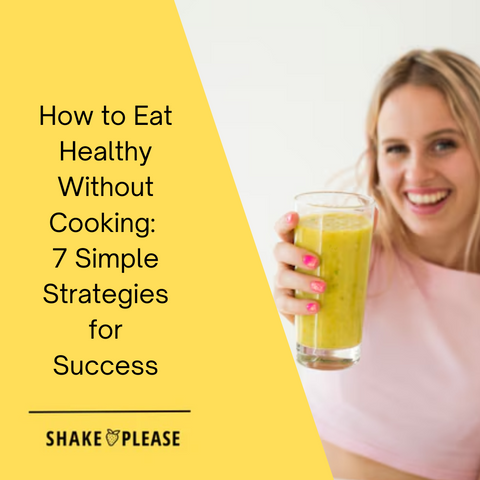
Planning for Easy Meals
Eating a healthy diet without cooking starts with a little planning. By organizing your meals in advance, you can avoid last-minute unhealthy choices and ensure that you always have nutritious options on hand.
-
Plan your meals for the week based on your schedule and dietary needs. This helps eliminate stress and makes it easier to stick to healthy eating habits.
-
Make a grocery list with healthy staples like whole grains, frozen vegetables, pre-cooked proteins, and fresh fruits. Keeping these essentials on hand ensures quick and balanced meals.
-
Consider meal prepping or bulk buying to cut down on time spent preparing food. Even without cooking, you can portion out ready-to-eat ingredients to make assembling meals easier.
-
Choose easy meal ideas like salads, wraps, and grain bowls, which require minimal preparation but still offer a balance of protein, fiber, and healthy fats.
-
Stick to simple and repeatable meals—if something works for you, there’s no need to overcomplicate it! Keeping meals familiar can make healthy eating feel effortless.
Convenience Foods for Healthy Eating
Eating a healthy, balanced diet even without cooking is easier when you have nutritious, ready-to-eat foods available. Stocking up on healthy convenience foods ensures that you always have quick meal options without relying on takeout or processed junk food.
-
Pre-cut veggies, cooked meats, and whole grain bread make it easy to assemble meals in minutes. These require little to no prep and are versatile for salads, wraps, or sandwiches.
-
Frozen fruits and vegetables are just as nutritious as fresh and last longer, making them an easy addition to smoothies, yogurt bowls, or quick stir-fries.
-
Canned protein sources like beans, tuna, and chicken are excellent options for quick meals. They provide protein, fiber, and essential nutrients with minimal effort.
-
Keep a stash of healthy snacks like nuts, seeds, and dried fruit for when hunger strikes. These snacks provide healthy fats and sustained energy without the need for cooking.
-
Always check nutrition labels and choose foods that are low in added salt, sugar, and preservatives to keep your meals as wholesome as possible.
Healthy Snacking
Snacking on whole grains can be a healthy food simple way to fuel your body throughout the day, especially when cooking isn’t an option. Instead of reaching for processed snacks, opt for nutrient-dense choices and whole grains that support your health.
-
Fruits, veggies, and protein-rich snacks provide essential vitamins, fiber, and energy to keep you going.
-
Keep fresh fruit visible, like a bowl of apples or bananas on the counter, to make healthy choices effortless.
-
Trail mix or nuts can be a quick, portable option that provides protein and healthy fats without any prep.
-
Get creative with your snacks by pairing different flavors and textures, like hummus with veggie sticks or Greek yogurt with berries and seeds.
-
For an easy, nutritious snack on the go, ShakePlease smoothies offer high-protein, real fruit blends that require no prep—just blend and enjoy. Options like:
-
Strawberry Banana Protein Smoothie – A classic, naturally sweet combo packed with nutrients.
-
Pineapple Berry Protein Smoothie – A tropical mix that delivers a refreshing, energy-boosting snack.
-
Chocolate Peanut Butter Banana Smoothie – A rich, satisfying treat that fuels your body with protein and healthy fats.
-
Healthy snacking doesn’t have to be complicated. Choosing whole grains, foods and simple, nourishing options can help you stay on track and eat healthy, without needing to cook.
A Guide to Protein, Carbs, and Fats In Smoothies
Eating Healthy on a Budget
Eating well doesn’t say that healthy meals and healthy ingredients always have to be expensive—smart grocery shopping and meal planning can help you make healthy recipes stay on track while keeping costs low.
-
Buy in bulk whenever possible. Staples like oats, rice, beans, and lentils are cost-effective and can be stored for long periods.
-
Plan your meals around sales and discounts. Check store flyers or use grocery store apps to find deals on nutritious foods.
-
Choose affordable protein sources like beans, lentils, eggs, and canned fish, which provide essential nutrients at a fraction of the cost of fresh meats.
-
Shop for seasonal produce to get the best quality at the lowest prices. Seasonal fruits and vegetables are often cheaper and fresher than off-season imports.
-
Use coupons and discount codes when shopping online or at grocery stores. Many meal delivery services, including ShakePlease, offer discounts on first-time orders, making it easier to enjoy nutritious, ready-to-blend smoothies on a budget.
Prep Once, Eat Twice
Prepping meals ahead of time can save you time and reduce food waste, ensuring you always have something healthy to eat.
-
Cook in bulk—make a big batch of brown rice, quinoa, or roasted vegetables to use throughout the week.
-
Choose meals that reheat well—soups, grain bowls, and wraps can easily be made in advance and enjoyed later.
-
Repurpose leftovers by turning them into new meals. Leftover roasted chicken can be added to salads, tacos, or stir-fries, while cooked grains can be transformed into breakfast bowls or grain salads.
-
Consider freezing portions of meals or smoothies for easy grab-and-go options. ShakePlease smoothies, for example, are pre-portioned and freezer-ready—just add liquid and blend whenever you need a quick, nutritious meal.
By doing grocery shopping, planning most meals ahead and using budget-friendly strategies, you can both save money and eat healthy, satisfying meals without overspending or spending hours in the kitchen.
Adding Flavor Without Cooking
You don’t need to cook to make your meals more flavorful—simple ingredients and seasonings can transform any dish.
-
Use fresh herbs and spices like basil, cilantro, cinnamon, or turmeric to enhance flavor without adding extra calories or sodium.
-
Opt for healthy sauces and condiments such as hummus, guacamole, or Greek yogurt-based dressings to add richness and depth to your meals.
-
Get creative with toppings—sprinkle nuts, seeds, or crumbled feta on salads, wraps, or grain bowls for an extra crunch and burst of flavor.
-
Experiment with citrus—a squeeze of lemon or lime can brighten up dishes without the need for added salt or sugar.
Adding variety to your meals with flavorful, whole-food ingredients makes healthy eating more enjoyable eat healthy, and sustainable.
Protein Shake vs. Whole Foods: Your Guide to a Balanced Diet
Making Healthy Eating a Habit
Healthy eating is not about quick fixes—it’s about building long-term, sustainable healthy habits, that support your well-being.
-
Start small by setting realistic goals, like incorporating one extra serving of vegetables per day or swapping sugary snacks for a protein-packed alternative.
-
Find a support system—whether it’s a friend, online community, or nutrition group, having a network can keep you accountable and motivated.
-
Allow yourself balance—occasional indulgences are part of a healthy lifestyle, so enjoy treats in moderation without guilt.
-
Make nutrition convenient—having ready-to-blend smoothies like ShakePlease on hand can help you stay on track with minimal effort.
Healthy eating is a journey, not a destination—small, consistent choices lead to lasting results.
Adding Flavor Without Cooking
You don’t need to cook to make your meals more flavorful—simple ingredients and seasonings can transform any dish.
-
Use fresh herbs and spices like basil, cilantro, cinnamon, or turmeric to enhance flavor without adding extra calories or sodium.
-
Opt for healthy sauces and condiments such as hummus, guacamole, or Greek yogurt-based dressings to add richness and depth to your meals.
-
Get creative with toppings—sprinkle nuts, seeds, or crumbled feta on salads, wraps, or grain bowls for an extra crunch and burst of flavor.
-
Experiment with citrus—a squeeze of lemon or lime can brighten up dishes without the need for added salt or sugar.
Adding variety to your meals with flavorful, whole-food ingredients makes healthy eating more enjoyable and sustainable.
Making Healthy Eating a Habit
Healthy eating is not about quick fixes—it’s about building long-term eat healthy, sustainable habits that support your well-being.
-
Start small by setting realistic goals, like incorporating one extra serving of vegetables per day or swapping sugary snacks for a protein-packed alternative.
-
Find a support system—whether it’s a friend, online community, or nutrition group, having a network can keep you accountable and motivated.
-
Allow yourself balance—occasional indulgences are part of a healthy lifestyle, so enjoy treats in moderation without guilt.
-
Make nutrition convenient—having ready-to-blend smoothies like ShakePlease on hand can help you stay on track with minimal effort.
Healthy eating is a journey, not a destination—small, consistent choices lead to lasting results.
Conclusion
Eating healthy without cooking is entirely possible with the right planning, smart grocery shopping, and simple meal strategies. By stocking up on frozen veggies, frozen fruit, chopped veggies, rotisserie chicken, canned tuna, canned beans, and hard-boiled eggs, you can create nutritious meals in minutes without turning on the stove.
Focusing on ready-to-eat, wholesome ingredients ensures that you always have balanced meal options at your fingertips. Whether you’re assembling salads, wraps, or protein-packed bowls, keeping nutrient-dense foods on hand allows you to make healthy choices effortlessly.
Incorporating flavorful, whole-food ingredients like herbs fresh veggies, spices, and healthy condiments can make meals more enjoyable without the need for extra cooking. And when time is tight, ShakePlease smoothies offer a quick, nutritious meal that requires zero prep—just blend and go.
Healthy eating is about sustainable habits and convenience. By planning healthy meals ahead, making smart food choices, and keeping your kitchen stocked with simple, nutrient-rich options, you can maintain a balanced diet without cooking while enjoying meals that support your well-being.





